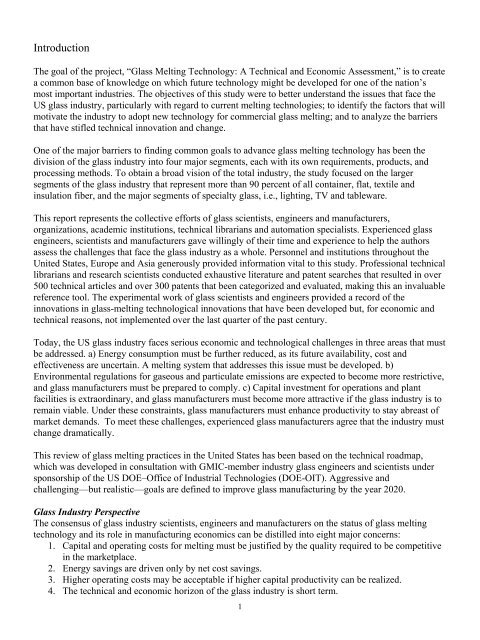Glass Melting Technology: A Technical and Economic ... - OSTI
Glass Melting Technology: A Technical and Economic ... - OSTI
Glass Melting Technology: A Technical and Economic ... - OSTI
You also want an ePaper? Increase the reach of your titles
YUMPU automatically turns print PDFs into web optimized ePapers that Google loves.
Introduction<br />
The goal of the project, “<strong>Glass</strong> <strong>Melting</strong> <strong>Technology</strong>: A <strong>Technical</strong> <strong>and</strong> <strong>Economic</strong> Assessment,” is to create<br />
a common base of knowledge on which future technology might be developed for one of the nation’s<br />
most important industries. The objectives of this study were to better underst<strong>and</strong> the issues that face the<br />
US glass industry, particularly with regard to current melting technologies; to identify the factors that will<br />
motivate the industry to adopt new technology for commercial glass melting; <strong>and</strong> to analyze the barriers<br />
that have stifled technical innovation <strong>and</strong> change.<br />
One of the major barriers to finding common goals to advance glass melting technology has been the<br />
division of the glass industry into four major segments, each with its own requirements, products, <strong>and</strong><br />
processing methods. To obtain a broad vision of the total industry, the study focused on the larger<br />
segments of the glass industry that represent more than 90 percent of all container, flat, textile <strong>and</strong><br />
insulation fiber, <strong>and</strong> the major segments of specialty glass, i.e., lighting, TV <strong>and</strong> tableware.<br />
This report represents the collective efforts of glass scientists, engineers <strong>and</strong> manufacturers,<br />
organizations, academic institutions, technical librarians <strong>and</strong> automation specialists. Experienced glass<br />
engineers, scientists <strong>and</strong> manufacturers gave willingly of their time <strong>and</strong> experience to help the authors<br />
assess the challenges that face the glass industry as a whole. Personnel <strong>and</strong> institutions throughout the<br />
United States, Europe <strong>and</strong> Asia generously provided information vital to this study. Professional technical<br />
librarians <strong>and</strong> research scientists conducted exhaustive literature <strong>and</strong> patent searches that resulted in over<br />
500 technical articles <strong>and</strong> over 300 patents that been categorized <strong>and</strong> evaluated, making this an invaluable<br />
reference tool. The experimental work of glass scientists <strong>and</strong> engineers provided a record of the<br />
innovations in glass-melting technological innovations that have been developed but, for economic <strong>and</strong><br />
technical reasons, not implemented over the last quarter of the past century.<br />
Today, the US glass industry faces serious economic <strong>and</strong> technological challenges in three areas that must<br />
be addressed. a) Energy consumption must be further reduced, as its future availability, cost <strong>and</strong><br />
effectiveness are uncertain. A melting system that addresses this issue must be developed. b)<br />
Environmental regulations for gaseous <strong>and</strong> particulate emissions are expected to become more restrictive,<br />
<strong>and</strong> glass manufacturers must be prepared to comply. c) Capital investment for operations <strong>and</strong> plant<br />
facilities is extraordinary, <strong>and</strong> glass manufacturers must become more attractive if the glass industry is to<br />
remain viable. Under these constraints, glass manufacturers must enhance productivity to stay abreast of<br />
market dem<strong>and</strong>s. To meet these challenges, experienced glass manufacturers agree that the industry must<br />
change dramatically.<br />
This review of glass melting practices in the United States has been based on the technical roadmap,<br />
which was developed in consultation with GMIC-member industry glass engineers <strong>and</strong> scientists under<br />
sponsorship of the US DOE–Office of Industrial Technologies (DOE-OIT). Aggressive <strong>and</strong><br />
challenging—but realistic—goals are defined to improve glass manufacturing by the year 2020.<br />
<strong>Glass</strong> Industry Perspective<br />
The consensus of glass industry scientists, engineers <strong>and</strong> manufacturers on the status of glass melting<br />
technology <strong>and</strong> its role in manufacturing economics can be distilled into eight major concerns:<br />
1. Capital <strong>and</strong> operating costs for melting must be justified by the quality required to be competitive<br />
in the marketplace.<br />
2. Energy savings are driven only by net cost savings.<br />
3. Higher operating costs may be acceptable if higher capital productivity can be realized.<br />
4. The technical <strong>and</strong> economic horizon of the glass industry is short term.<br />
1

















